Episodes
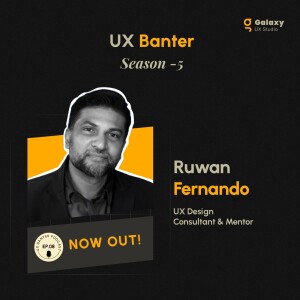
Tuesday Mar 04, 2025
Behind the Scenes of Game UX with Ruwan Fernando, S5, Ep. 8
Tuesday Mar 04, 2025
Tuesday Mar 04, 2025
In this episode, we are joined by Ruwan Fernando, a seasoned UX leader with expertise in AAA games, SaaS, and gamification. With experience across five countries, he brings a unique perspective on design, storytelling, and user engagement. Tune in as we explore his journey, industry insights, and the evolving role of UX in gaming.Discussion points:~ How did your journey into UX and game design begin? 1:45~ How did your expectations of the gaming industry change over time? 7:20~ Do you need to be a gamer to succeed in the industry? 12:50~ Rapid fire round 17:55~ What are you looking forward to at GDC, and how can people connect with you? 22:59~ Which of your work/accomplishments are you most proud of? 23:23~ What’s your top advice for aspiring game designers and UX professionals? 29:33Show notes: ~ UX is a job of communication. Design just happens along the way. UX is all about communicating your vision as someone making a product to the expectations of a user who's expecting to use it. It's shortening the distance between the two.~ Technology is experienced through the interface. If you don't build the interface, then you've built a technology that will never be experienced.~ The longer we leave people out of the discussion, the more the product itself fails to connect with its audience.~ We use things like pressure, time, scarcity, and tension to ramp up or down the emotional connection to a story. If a game isn’t emotionally engaging, it’s not an engaging story.~ If you only ever observe other people's solutions, what you're observing is a list of compromises that you have never seen. So you take that solution and all the compromises with it without understanding what they were. Then you build something based on compromises on which you further compromise.~ The minute you say ‘I prefer it this way,’ you take what is a wide-angle perspective and narrow it to one. But we need to appeal to millions of people, not just ourselves.~ Instead of going wide, I recommend you narrow focus, become incredible at it, and then graduate to the next.
Link:https://www.linkedin.com/in/ruwan-f/ https://adplist.org/mentors/ruwan-fernando

Tuesday Feb 25, 2025
Tuesday Feb 25, 2025
In this episode, we are joined by Kim Feenstra Kuiper, a senior UX researcher at King. With a background in AI and human-computer interaction, she has led impactful research at companies like Spotify and GoodNotes. Passionate about storytelling and mentorship, she empowers teams to create user-centered, meaningful designs.Discussion points -~ Tell us about your journey into UX research. 1:51~ Do you think the key difference between these worlds is the focus on logic versus human impact? 6:22~ How did you land roles at major companies like Spotify, King, and GoodNotes? 8:13~Do you think a strong portfolio matters more, or is it all about how you handle the interview? 10:53~ Rapid fire round 15:51~ How does working on widely used products, like Candy Crush or Spotify, impact the research process? 26:48Show notes -~ I never had a big goal of working at a major company. I just kept building my skills, taking opportunities as they came, and growing my network.~ Foundational research helps teams shape new products, validate ideas, and inspire innovation—it's about asking 'why' before jumping to 'what' and 'how'.~ A good UX research portfolio isn’t just about showcasing work; it’s about communicating impact in a way that both recruiters and hiring managers understand.~ Working on a widely used product means every research decision carries weight—you're not just solving for one group, but for millions of diverse users.~ The hardest part about breaking into UX research isn’t just skill—it’s networking, being in the right place, and finding people who can open doors for you.~ I love seeing messy sketches and raw research notes in portfolios—real work isn’t polished, and that’s what makes it authentic and valuable.Links -www.linkedin.com/in/kimfeenstrakuiperwww.careers.king.com
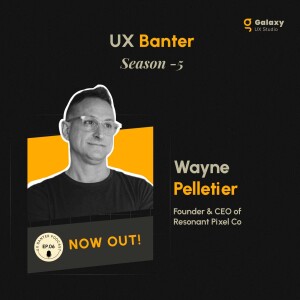
Monday Feb 17, 2025
Productizing Web Design: A Conversation with Wayne Pelletier, S5, Ep. 6
Monday Feb 17, 2025
Monday Feb 17, 2025
In this episode, we are joined by Wayne Pelletier, Founder and CEO of Resonant Pixel Company. With extensive experience in web design and digital strategy, Wayne is transforming the industry with a subscription-based model that simplifies website management for businesses. A Squarespace expert, he’s passionate about delivering scalable, high-value web solutions that empower brands to grow effortlessly.Discussion points -~ How did you start your career? 1:17~ What differentiates low-code and no-code platforms from traditional coding, and how has your experience in web development shaped your perspective on them? 4:16~Every business is essentially in the business of content creation. Can you elaborate on that concept and its importance for website success? 6:23~Do you think we are moving toward a 'post-website world,' and what role do social media and AI-driven feeds play in this shift? 8:21~ Rapid fire round 17:23~Your business operates on a subscription-based web design model. What makes this approach successful, and how does it benefit small businesses? 20:01~ How do you ensure a strong user experience for websites focused solely on information rather than business outcomes? 24:00~What advice would you give to young professionals or designers looking to build a long-term career in web design and digital strategy? 27:55Show notes -~ Understanding how things are built goes a long way to building better things, no matter your platform.~ When you have a website, you have a shack in the woods—without content and marketing, there's no traffic and no one around.~ The idea behind productizing services is to level out revenue so that it's mostly only ever-growing instead of dealing with the feast-or-famine cycle.~ Hiring you is a ton of work, and hiring someone else is also a ton of work—so clients don’t just leave as easily as people fear.~ From a UX standpoint, I’ve made hundreds of websites over the years, and I have a deep understanding of how user behavior differs across industries.~ Going to lunch and getting to know the people you work with now pays dividends—because one day, they’ll be decision-makers who need what you do.~ Social platforms sell fast, but the problem is when you make sales on another platform, those customers are not yours—you can’t contact them, and u don’t own that relationship.
Links -www.linkedin.com/in/waynepelletier/www.resonantpixel.co
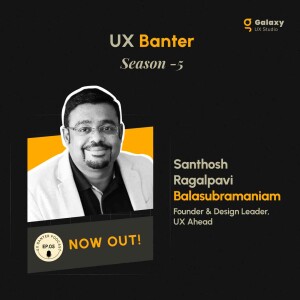
Thursday Feb 06, 2025
Thursday Feb 06, 2025
In this episode, we are joined by Santhosh Ragalpavi Balasubramaniam, a seasoned UX leader, design thinking facilitator, and founder of UX Ahead. With experience leading digital transformations for global brands like BP, HSBC, and SAP, he shares insights on inclusive design, UX leadership, and the evolving role of individual contributors in enterprise environments.Discussion points:~ What was your journey like when you decided to become a designer? Who inspired you, and how did you get here? 3:51~ Is a formal degree essential for a UX career, especially in regions like India, where company policies may require it? 18:33~ Rapid fire round 24:44~ Whenever the discussion arises about being an in-house designer versus an agency designer, it often gets framed as working at a startup or freelancing—how do you see this distinction, and do you think it's that simple? 31:01~ Being on the strategy side, are you ever tempted to pursue a role like Director of UX, Chief Design Officer, or Design Principal?40:10~ What advice would you give to aspiring UX professionals on choosing the right career path? 42:16Show notes: ~ As an individual contributor, you may not have decision-making authority, but you still need to influence decisions and drive collaboration across teams.~ Design is not just about making things look good; it’s about solving real problems for users and businesses alike.~ Early on, businesses didn’t understand why they needed UX. They just wanted a website or a brochure without considering the actual user needs.~ A designer’s job isn’t just to take requirements and create something in isolation—it’s about understanding the business, the users, and bridging that gap.~ The biggest challenge for UX professionals is not just mastering tools, but developing the ability to collaborate, influence, and educate stakeholders.~ Chasing job titles won’t make you a better designer. Focus on what you can learn and how you can apply your skills in real-world scenarios. ~ Mindset is key in design. You have to detach from your work, accept feedback, and always remember that design is about the user, not the designer.
Links:https://www.linkedin.com/in/santhoshrb/www.uxahead.com/
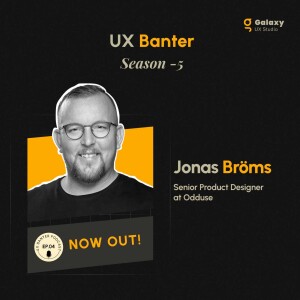
Wednesday Jan 29, 2025
Building Resilience and Mentorship in UX Design: Insights from Jonas Bröms, S5, Ep. 4
Wednesday Jan 29, 2025
Wednesday Jan 29, 2025
In this episode, we are joined by Jonas Bröms, a globally recognized senior product designer and mentor with years of expertise in UX and user-centered design. Named among the top product designers worldwide, Jonas combines creative brilliance with technical acumen to craft impactful digital solutions for innovative startups. From overcoming personal and professional challenges to shaping the future of UX through mentorship, Jonas shares valuable insights that inspire and empower the next generation of designers.Discussion Points:~ How does it feel to be recognized as the top authority in your field and at the top of your game? 1:30~ You’ve been deeply involved in mentorship; what inspired you to start mentoring, and how has it impacted your own growth? 8:28~ How has traveling and working across Sweden, UAE, Cyprus, and other places shaped you as an individual and professional? 12:16~ What advice would you give to your younger self or to those who want to follow in your footsteps? 26:38~ As technology evolves, what are your thoughts on the future of UX design, especially with AI and voice interfaces changing user interactions? 30:50Show notes:~ I haven’t sunk it in yet, but I try not to feed my impostor syndrome. Instead, I focus on being proud of what I’ve achieved and the people I’ve helped along the way.~ Mentorship has been a journey where I not only help others but also gain perspective on myself and my work. It’s a transfer of knowledge and experiences that challenges and inspires me.~ When everything fell apart last year, I remembered a friend's advice: 'Do something for somebody else.' It changed my perspective and gave me purpose during difficult times.~ The way we interact with technology is going to change drastically. It’s no longer just about screens; it’s about creating experiences through voice, augmented reality, and more natural interactions.~ Be inspired by what others create instead of feeling afraid or envious of it. Use it to fuel your own journey and creativity.~ The accumulation of small, meaningful questions over time leads to deeper understanding and better collaboration.
Links:www.linkedin.com/in/jonas-broms/www.odduse.com
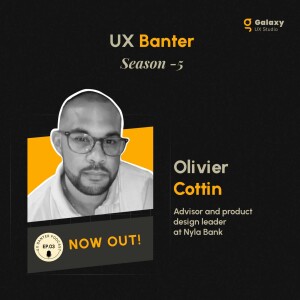
Monday Jan 20, 2025
Global Design and Innovation: Lessons from Olivier Cottin, S5, Ep.3
Monday Jan 20, 2025
Monday Jan 20, 2025
In this episode, we are joined by Olivier Cottin, an experienced product design leader with 18 years in venture building and human-centered design. Olivier has worked with top companies like Careem, Uber, and Shell, helping startups achieve product-market fit through innovative design strategies. Currently an advisor and product design leader at Nyla Bank, he brings invaluable insights into transforming customer needs into successful digital products.Discussion points -~ Can you share your journey with us and what it has been like so far? 1:46~ How has your multicultural and diverse background influenced your approach to work? 7:28~ Rapid fire round 10:45~ How has your background in human-computer interaction shaped your approach to fintech design and understanding user psychology? 16:54~ How does designing for Middle Eastern and Asian markets differ from working in Europe or the West? 20:28~ Now that you’re on the other side as a venture capitalist, how has that perspective shifted your approach to design and innovation? 28:59~ What common mistakes do you see in startup pitches, and what advice would you offer to entrepreneurs to stand out. 30:16
Show notes -
~ I’ve realized there’s a whole part of the world that does things differently. It’s not that it’s the wrong way; it’s just different, and it takes time to adapt and relearn.~ In emerging markets, it’s not always about the quality of execution; it’s about being first to market, locking in your distribution, and eliminating competition early.~ Founders often get so obsessed with their product that they skip validation, pouring time and money into something without knowing who will buy it or how to distribute it.~ Having a mixed heritage and career across different regions has taught me to approach problems with multiple perspectives and adapt to unique ways of doing things.~ Accounting taught me the value of structure, but I also realized that creativity within such rigid frameworks often leads to undesirable consequences.~ Business is all about people. To create value, you need to deeply understand your customers—their behaviors, demographics, and what problems you’re solving for them.Links -www.linkedin.com/in/oliviercottinwww.nylabank.com
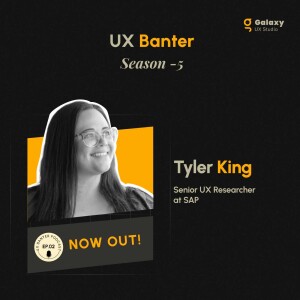
Monday Jan 13, 2025
What Makes Enterprise UX Exciting? Insights from Tyler King, S5, Ep. 2
Monday Jan 13, 2025
Monday Jan 13, 2025
In this episode, we’re joined by Tyler King, Senior UX Researcher at SAP, with over 10 years of expertise in human-centered design, product strategy, and driving UX maturity in enterprises. Tyler discusses her journey of transforming customer insights into successful digital products, the complexities of designing for large-scale systems, and why storytelling is a vital skill for UX professionals.Discussion Points -~ How does it feel to be a design leader, and what has your journey been like in spreading ideas at the enterprise level, especially in complex industries? 1:47~ When you're dealing with a large product-based company with multiple product managers and owners, how do you prioritize tasks? 8:06~ How do you quantify data from diverse users, especially when they aren't software professionals? 10:31~ Rapid fire round 12:31~ Do you miss working in the B2C market? 16:50~ Is there any technology that you are really excited about, specifically regarding AI or quantum computing? 21:25~ Do you have any upcoming conferences you're attending? 22:57~ What advice do you have for people who want to follow your footsteps in UX, especially for junior UX professionals? 24:02
Show notes -~B2B has really, really complex systems. And it's a really interesting space if you're into problem-solving.~ Enterprise UX is often the most neglected side of design because people think that users are getting paid to use the software, so functionality takes priority over experience.~ Being in the enterprise space, it's less obvious, but the challenges are always complex, and solving them is immensely rewarding.~ I think the most important skill for junior UX designers is storytelling. It's what gets your stakeholders on board and helps them understand your work.~ In enterprise, the interfaces may not be as sexy as Netflix, but if you're excited by solving complex problems, you'll never be bored.~ When you're working on mission-critical applications, the impact is significant—it's not just about making something look good; it’s about making sure it works for the people who rely on it.
Links:
LinkedIn: www.linkedin.com/in/tyler-nicole-king/Website: www.sap.com
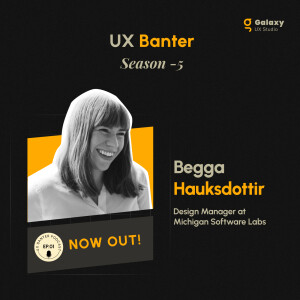
Monday Jan 06, 2025
Discover the Secrets of Creative Curiosity with Begga Hauksdottir, S5, Ep1
Monday Jan 06, 2025
Monday Jan 06, 2025
In this episode, we’re joined by Begga Hauksdottir, User Experience Director at TrusTrace, with over 12 years of expertise in product design, digital innovation, and user experience. Begga discusses her passion for creating impactful solutions, guiding teams through user-centric methodologies like design thinking, and driving meaningful change through design.Discussion Point:
What was your professional journey like and what shaped you as a design professional? 2:56
Did you notice any cultural shifts when the smaller design studio you worked at was acquired by the larger organization? 5:57
How do you think the cultural experiences from living in Iceland, Italy, and Sweden have influenced your approach to design and the work you do now? 8:57
Rapid fire round 15:15
What are the key challenges you face in managing your remote team in India while working in a B2B structure, and how do you address those challenges? 20:17
As a design leader, what key qualities do you want your team to develop, and what measures are you taking to foster those qualities within your team? 26:03
What advice would you give to young designers aspiring to follow in your footsteps? 27:13
Show notes:
As creative professionals, it becomes our responsibility to stay foolish, stay curious, keep discovering things, and keep knowing what is new to come.
Even though we have the repository, we always want to recheck the data with a smaller sample to validate what information we already have, because every year or so, a new product comes into the market, and people's perceptions might change.
We have to design very quickly, working with certain knowledge and biases, but it’s crucial to constantly check: Am I still on the right track? Are there knowledge gaps that have come up?
Expose yourself to a lot of things early on. Don’t just go for the first comfortable position. Test out what resonates with you, because being unhappy at work for 40 years won’t make good products—or you—happy.
It’s not about having a sleek, beautiful portfolio for me—it’s about solving meaningful problems. Find what resonates with you, not what looks good on paper.
Keep networking, engaging, listening to podcasts, and reading books. That’s the journey for any career, but especially for a designer.Links -Linkedin - https://www.linkedin.com/in/berglindhauksdottir/Company’s Website - http://www.trustrace.com
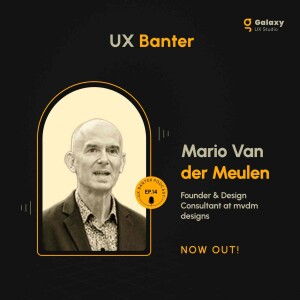
Wednesday Oct 23, 2024
Wednesday Oct 23, 2024
In this episode, we are joined by Mario Van der Meulen, the founder of MVDM Designs. Mario is a human-focused, insights-driven experience design leader and innovation strategist, with nearly 30 years of experience in the design industry. He has been instrumental in helping organizations around the world and serves as a mentor at ADP List. Discussion points: ~ Can you briefly share your journey from starting in Europe to ending up in Singapore over the past 30 years? 1:53~ Many designers face challenges when entering the market, especially when it comes to language barriers. What advice do you have for navigating these situations? 7:48~ Do research methods or insights change when moving between different countries or regions? 9:31~ Rapid fire round 11:21~ How do you handle vague, non-actionable feedback based on gut feelings, especially when there are no clear, constructive points to work with? 18:47~ Do you see a significant visual difference in web design between content-heavy styles in some countries and the minimalistic approaches in others? How do these contrasting styles affect global designers in choosing a direction? 26:22~ Where will you be speaking at conferences in the coming days, and how can people meet you in person to learn more? 35:40Show notes:~ The primary goal of design should always be to serve the user. Understanding their needs and behaviors is essential for creating impactful experiences.~ Criticism should be seen as an opportunity, not a setback. It brings diverse perspectives that can elevate our work.~ Design does not exist in a vacuum; it's influenced by cultural contexts. What resonates in one culture might not in another.~ While designs should look good, they must also be practical and intuitive. The balance between beauty and function is key.~ Decisions in design should be backed by data and user research. Validating our choices ensures they truly meet user needs.~ Clear communication about design decisions builds trust with stakeholders and ensures alignment with business goals.Links:LinkedIn: https://www.linkedin.com/in/mariovdm/Website: https://www.mvdm.me
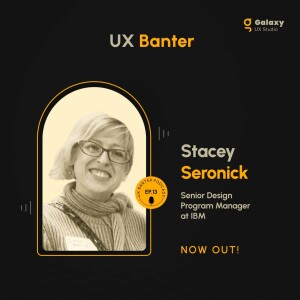
Wednesday Oct 16, 2024
Empowering Women in Design: A Conversation with Stacey Seronick, S4, Ep. 13
Wednesday Oct 16, 2024
Wednesday Oct 16, 2024
In this episode, we are joined by Stacey Seronick, the Senior Design Program Manager at IBM. With a wealth of experience in developing educational programs for designers and researchers, Stacey is passionate about service design, employee experience, and generative research. Join us as we explore her journey in the design industry, the importance of ethical design, and her insights on mentorship and collaboration in building impactful user experiences. Discussion point:
Can you share your journey and how you got to where you are today? 1:39
When did you move to California? 16:10
Do you feel that your overall experiences have contributed significantly to your journey? 22:13
Rapid fire questions 24:17
At IBM, you've mentioned working with IBM India and traveling frequently. What are the main focuses of your initiatives there? 31:20
Show notes:
The path to a better place was not to come barreling in and say, ‘I have all the answers'.
I needed to work with women to empower them to realize they can and need to be the future they want to be a part of.
It’s so unhealthy and cruel to think that because you had a bad experience, everyone else should go through it too.
True innovation happens when you stop trying to control every aspect and embrace the unknown.
The most impactful designs come from listening deeply and creating with empathy at the core.
Leadership is about making space for others to shine, not just being the brightest in the room.
The future of design is in diversity—not just of gender or background, but diversity of thought and experience.
Links:LinkedIn: www.linkedin.com/in/stacey-seronick/ Company website: www.ibm.com

A fun and conversational podcast where the design industry experts share their story, learnings, and the processes they follow to create successful digital products and user experiences.








